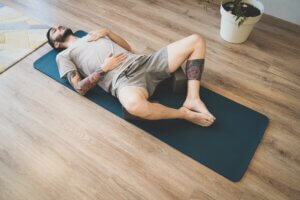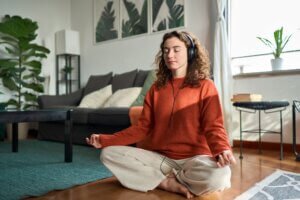Mind & Body
Techniques to Calm Anxiety in the Moment
“Breath in, breath out.” Sounds easy, right? Well, not always. The truth is, techniques for quieting your mind and calming anxiety aren’t one-size-fits-all. But it is possible—and just as important—to establish strategies you can turn to when needed to help reduce stress. Here are simple, reliable tips and techniques for winding down when you need to.
Breathing-Based Techniques
 By activating the parasympathetic nervous system, breathing techniques combat your body’s flight or fight response to stressful situations. Controlled breathing slows your heart rate, lowers your blood pressure and reduces stress hormones. The result can be a sense of calm and relaxation. These basic breathing techniques are powerful tools in reducing anxiety.
By activating the parasympathetic nervous system, breathing techniques combat your body’s flight or fight response to stressful situations. Controlled breathing slows your heart rate, lowers your blood pressure and reduces stress hormones. The result can be a sense of calm and relaxation. These basic breathing techniques are powerful tools in reducing anxiety.
4-7-8 Breathing
This circular technique involves breathing in for a count of four, holding your breath for a count of seven and then exhaling for a count of eight. Make sure to inhale through your nose and exhale completely through your mouth. Repeat up to four times.
Box (Square) Breathing
This grounding, calming practice requires you to breathe in for four seconds, hold your breath for four seconds, exhale for four seconds and then hold your breath again for four seconds before repeating the process. Think of each act as one side of a square.
Belly Breathing vs. Chest Breathing
If you’ve ever taken a yoga class, you’ve probably heard the term “belly breathing.” Also known as diaphragmatic breathing, this approach utilizes the large muscle below the lungs to enhance oxygen intake. Simply focus on engaging and expanding your abdomen when you inhale, versus simply relying on your chest muscles to expand your rib cage.
Grounding and Sensory Techniques
 If you find yourself becoming anxious for no reason, or you’re in an anxiety-inducing situation such as on an airplane or preparing for a job interview, try these techniques to reestablish calm.
If you find yourself becoming anxious for no reason, or you’re in an anxiety-inducing situation such as on an airplane or preparing for a job interview, try these techniques to reestablish calm.
Cold Water and Temperature Techniques
Yes, sometimes a splash of cold water can bring a jolt to your body, but if you go at it with the intention to calm down, it can be an incredibly effective way to do so. Cold water stimulates the parasympathetic nervous system, increasing blood circulation and endorphin release.
5-4-3-2-1 Grounding Method
Start by taking a few deep breaths, then identify five things you can see (all different objects), four things you can feel (textures, fibers, the wind blowing through your hair), three things you can hear (bird song, bell tower, crosswalk chimes, etc.), two things you smell and one thing you can taste, such as a piece of gum, sip of water or coffee.
Progressive Muscle Relaxation
While this practice can take as long as you need it to (and is most beneficial when you move through your entire body), the short version of this deep relaxation technique is also effective. While in a relaxing position, such as sitting or laying down with your hands and arms out to your sides, tense specific muscle groups; hold the tension for a few seconds; release the tension. Start at the top of your body with your face and shoulders and move down, or begin with larger muscle groups like your legs before moving onto smaller ones like hands and feet.
Cognitive and Mental Techniques
 Sometimes finding calm can be as simple as taking a few moments to focus on your favorite mental technique. Here are a few.
Sometimes finding calm can be as simple as taking a few moments to focus on your favorite mental technique. Here are a few.
Visualization and Mental Imagery
Or, in other words, happy day dreaming. Turning negative feelings and stressful situations around can be as simple as revisiting a happy memory, visualizing a comforting scene or faraway place or playing out a positive outcome in your mind.
The STOP Method
This quick-and-easy strategy comes with a handy acronym:
- Stop, pause and acknowledge your feelings and why you’re experiencing them.
- Take a breath.
- Observe your surroundings, emotions and physical sensations that might be affecting your current mental state.
- Proceed. Move forward based on what you’ve just acknowledged and felt.
Realistic Self-Talk and Reframing
Being too hard on yourself can be a tough habit to break. One strategy involves reframing negative thoughts with positive self affirmations. Challenge ideas that make you feel anxious. Be patient with yourself as your mind adjusts to a more positive and self-affirming approach to the moment.
Physical Movement and Positioning
 While the ultimate goal is a more relaxed mental state, sometimes being physical can help you get there.
While the ultimate goal is a more relaxed mental state, sometimes being physical can help you get there.
Strategic Body Positioning
Be mindful of your body and put it in a position that brings you calm and comfort, such as a certain yoga pose, meditation posture or balancing. This can be particularly effective as you get ready to fall asleep.
Gentle Movement Options
Changing your body position can drastically alter your mental state. If you’re looking for physical ways to produce mental clarity, try tai chi, yoga or walking meditation.
4-7-8 Breathing
Applying light pressure to certain points on the body can help with energy flow and stress reduction. Common pressure points to try are:
- The area between the thumb and index finger
- Breastbone
- Inner wrist
- Upper shoulders
- Base of the neck
- Between the eyebrows
- Temples
Environmental and Situational Strategies

While you often can’t control your larger environment, you can control the physical space closest to you. If you find yourself becoming overwhelmed, altering your environment—even in small ways—can make a huge difference. Here are a variety of ways you can alter how the space around you for better mental clarity.
Creating Micro-Environments
Need an escape to clear your mind? Creating a small space, known as a micro-environment, is a good way to establish a safe space. Opt for small nooks and well-lit areas with calming features such as plants, art and soothing colors.
Excuse Strategies for Social Situations
If large groups trigger an anxious mind, have a few excuses at the ready to help you pivot to a new environment or exit the situation entirely, and be mindful to avoid alcohol in social settings as it can lead to anxiousness. Keep your reasoning vague and as honest as possible. Things like:
- “I’ll be back shortly.”
- “I had another commitment come up.”
- “I need to make a phone call.”
Technology Aids: A variety of technological advances can help calm anxiety. Try the following techniques for easy relaxation:
- Meditation apps
- Virtual reality (VR)
- Noise-cancelling headphones or ear plugs to drown out loud noises
- Sensory-friendly clothing
- A weighted blanket
- White noise machines
- Heart rate monitor or other biofeedback device
Building Your Personal Toolkit
 Establishing a reliable calming practice or multiple mechanisms you can turn to in times of stress is essential to your mindfulness skillset. Personalizing the approach makes it more likely you’ll use the techniques and ensures the effects are positive and long-lasting.
Establishing a reliable calming practice or multiple mechanisms you can turn to in times of stress is essential to your mindfulness skillset. Personalizing the approach makes it more likely you’ll use the techniques and ensures the effects are positive and long-lasting.
Once you’ve identified the strategies that work for you, practice them during calm moments so you can enact them when stressful situations emerge. Also make a mental note of warning signs that might be triggers for your anxiety and be proactive in using the methods that work for you in moments of potential anxiousness.
Conclusion
The beauty of many of these calming techniques for anxiety is you’re often the only person who knows you’re using them. They’re personal, meaningful to you and your individual set of circumstances. Developing calming strategies helps reduce stress and lets you move through your day with peace of mind and calm focus. If the stress you experience interferes with your daily life, please reach out to a behavioral health specialist.





